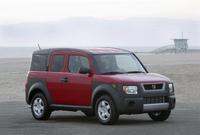2005 Honda Element EX Review
THE AUTO PAGE By JOHN HEILIG
SEE ALSO: New Car Buyer's Guide for Honda
SPECIFICATIONS MODEL: Honda Element EX ENGINE: 2.4-liter DOHC inline four HORSEPOWER/TORQUE: 160 hp @ 5,500 rpm/161 lb.-ft. @ 4,500 rpm TRANSMISSION: 5-speed manual WHEELBASE: 109.5 in. LENGTH x WIDTH x HEIGHT: 186.6 x 73.3 x 67.7 in. TIRES: P215/70R16All-Season ECONOMY: 21 mpg city/24 mpg highway PRICE: $21,440
By consensus, the Honda Element is not the prettiest car on the highway. In fact, it's close to being the ugliest, simply because of its shape and Honda's tendency to cloth the element in some of the weirdest paint combinations I've seen. The paint schemes only serve to emphasize the unique shape. But then, maybe that's what Honda wanted to do in the first place. Our tester wore the Element's new color - Cargo Khaki. That, along with black highlights over the rear roof and black front fenders, adds to the mystique.
Enough about physical beauty. Remember when someone was trying to set you upon a blind date and the date's only asset was a good personality? Well, the Honda Element has personality to spare.
The Element isn't for cruising the highway at ungodly speeds. Rather, it's for loading up with all your gear and heading off the highway to camp, or mountain bike, or kayak, or hike, or whatever. The Element has tons of room to carry all your gear, too. Behind the rear seat is 25 cubic feet of cargo volume. The split rear seats fold to give you more cargo volume. And you can remove the rear seats (not an easy chore) to make the element a serious hauler. If you're the only one in the car and you have a surfboard, for example, you can fold down all the seats, including the front passenger's, and carry the board inside.
With all the seats removed, there is a flat floor. The floor surface isn't fancy carpet, it's a rubber mat. If necessary, you can actually hose out the element if there's too much mud and gook there. One word of caution, though. When the rubber is wet, it's slippery. We never actually hosed out the Element, but we did drive it in heavy rain, and our shoes were wet when we entered the car. So we simulated hosing out the car.
The tailgate opens in two ways. You can lift just the glass, which leaves you with a small ledge to lift over. Or, you can lower the metal part of the tailgate for a flat, wide open, cargo door. Even when the most rugged cargo we carried was a bag of trail mix among our groceries, we chose to open the rear for maximum loading area.
Under the hood of the element is a 2.4-liter double-overhead-cam four cylinder engine that's rated at 160 horsepower. Coupled to a 5-speed manual transmission - with the shifter on the dash - there was plenty of power for our applications. We took the Element on our mountain test road, and it climbed with the best of them.
The engine tended to be slightly buzzy on hard acceleration, but under a constant load at normal speeds it wasn't noisy at all.
The Element has a compliant suspension that offers a smooth ride on smooth roads and can handle curves well. Realize, though, that the Element has the aspect ratio of a sport utility and, therefore, isn't a sports car.
I noticed that there wasn't a lot of wind noise at highway speeds, which is nice in a small car, especially this one with its boxy shape.
We had the AWD package in our tester. This came in handy driving in the rainstorm mentioned above. Still, it was possible to spin the front wheels on hard acceleration.
The front seats were comfortable. The rear seat offered excellent legroom for adults. However, the rear seating was "theatre seating," meaning that the rear seats were raised slightly over the front seats. When we had an adult male in the rear seat, he had to tilt the seat back to gain enough headroom. As it was, his head was in the recess in the roof caused by the rear sunroof. He wasn't totally reclined, but he did have to move the seat. And the theatre seating was a waste, because in this position he couldn't see anything.
Among the options was power windows, with an automatic up AND DOWN feature. We have driven much more expensive cars that don't offer automatic up.
The engine bay was unobstructed by huge covers, so everything was exposed. It is easy to find whatever you're looking for under there, and it's probably easy to work on, too. I was fascinated to note that the element is an American car. Seventy percent of the parts are of US or Canadian origin; 20 percent are Japanese. The Element is assembled in East Liberty, Ohio. There are American nameplate cars with smaller US parts content.
At a sticker price of $21,440, the Element is not ridiculously cheap. But it does offer practicality and decent economy. We also had AWD and satellite radio, a pair of assets that will make any vehicle worthwhile.
© 2005 The Auto Page Syndicate



